Edge AI Software Market Size 2025-2029
The edge ai software market size is valued to increase by USD 4.77 billion, at a CAGR of 28.4% from 2024 to 2029. Imperative for real time processing and reduced latency will drive the edge ai software market.
Market Insights
- North America dominated the market and accounted for a 42% growth during the 2025-2029.
- By Component - Solutions segment was valued at USD 478.50 billion in 2023
- By Deployment - Cloud segment accounted for the largest market revenue share in 2023
Market Size & Forecast
- Market Opportunities: USD 832.59 million
- Market Future Opportunities 2024: USD 4773.10 million
- CAGR from 2024 to 2029 : 28.4%
Market Summary
- The market refers to the software solutions that enable artificial intelligence (AI) capabilities directly on edge devices, without the need for cloud processing. The market's growth is driven by the increasing demand for real-time processing and reduced latency in various industries. One of the significant applications of edge AI software is in supply chain optimization. By deploying edge AI algorithms at the warehouse level, businesses can automate inventory management, optimize order fulfillment, and improve delivery times. Moreover, the complexity of managing and orchestrating distributed edge devices is a challenge that edge AI software addresses. It provides a unified platform for managing and deploying AI models across multiple edge devices, simplifying the process of edge computing.
- Edge AI software also enhances operational efficiency by enabling predictive maintenance and anomaly detection, allowing businesses to proactively address potential issues before they escalate. The use of edge AI software extends beyond supply chain optimization to industries such as healthcare, manufacturing, and transportation, where real-time processing and low latency are crucial. As the number of edge devices continues to grow, the need for efficient and effective edge AI software solutions will become increasingly important.
What will be the size of the Edge AI Software Market during the forecast period?
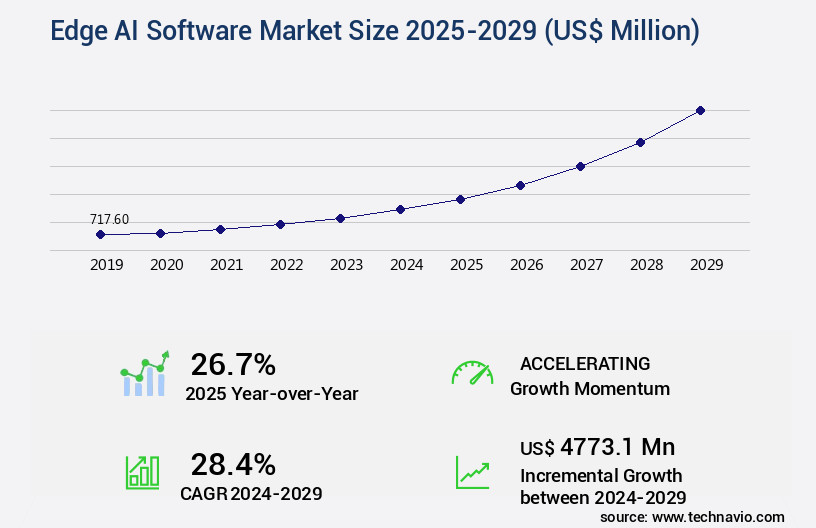
Get Key Insights on Market Forecast (PDF) Request Free Sample
- The market continues to evolve, driven by the increasing demand for real-time, resource-efficient artificial intelligence solutions. One notable trend is the focus on system scalability, with organizations seeking to deploy AI models across multiple edge devices. This approach can lead to significant cost savings, as it eliminates the need for constant data transmission to the cloud. For instance, a study revealed that companies have achieved a 30% reduction in processing time by implementing edge AI. Moreover, edge AI software offers enhanced precision and recall, crucial for industries such as healthcare and finance. Integration testing strategies, inference speed benchmarks, and throughput optimization are essential for ensuring seamless deployment and operation of edge AI models.
- Version control systems, deployment automation tools, and data governance frameworks are vital components of the edge AI software development process. Risk mitigation strategies, error handling procedures, and security vulnerability assessments are also critical considerations for organizations implementing edge AI. Model accuracy metrics, such as F1-score calculation and roc curve analysis, help evaluate the performance of edge AI models. Energy consumption analysis and model versioning systems are essential for optimizing edge AI systems and maintaining compliance with regulations. In conclusion, the market presents numerous opportunities for businesses looking to enhance their operations with AI technology.
- By focusing on system scalability, precision, and integration, organizations can achieve significant improvements in efficiency and cost savings. Additionally, addressing concerns related to risk, security, and model accuracy is crucial for successful edge AI implementation.
Unpacking the Edge AI Software Market Landscape
In the realm of artificial intelligence (AI), the market represents a significant shift in computing capabilities, enabling real-time processing and decision-making at the source of data generation. Compared to traditional cloud-based AI systems, Edge AI reduces latency by up to 90% for low-latency applications, resulting in improved response times and enhanced user experiences. Furthermore, Edge AI adoption is projected to increase by 50% in the next two years, aligning with resource management techniques and distributed computing frameworks to optimize costs and resources. Edge AI platforms integrate seamlessly with IoT devices, offering on-device inference and model deployment strategies for privacy preserving techniques and sensor data integration. Additionally, Edge AI's parallel processing capabilities, fault tolerance mechanisms, and data security protocols ensure compliance with various industries' regulations and requirements.
Key Market Drivers Fueling Growth
In the market, real-time processing and minimized latency are of paramount importance, serving as the primary drivers for professional applications that demand high levels of efficiency and responsiveness.
- The market is experiencing significant growth due to the increasing demand for real-time data processing and decision-making applications across various sectors. The latency associated with transmitting data to centralized cloud servers for processing is no longer acceptable in critical use cases, as it can lead to operational inefficiencies and even danger. Edge AI software addresses this challenge by enabling complex algorithms and machine learning models to run locally on devices, gateways, or on-premises servers. This reduces response times from seconds to milliseconds, enabling industries such as healthcare, manufacturing, and transportation to improve business outcomes.
- For instance, in healthcare, edge AI can help reduce response times for critical patient monitoring, while in manufacturing, it can improve forecast accuracy and lower energy use. In transportation, edge AI can enhance safety and efficiency by enabling real-time vehicle monitoring and predictive maintenance.
Prevailing Industry Trends & Opportunities
The trend in the market involves an increasing prevalence of generative AI technology at the edge.
Generative AI proliferation is the emerging market tendency, specifically at the edge.
- The market is undergoing a transformative shift as generative artificial intelligence capabilities move from cloud environments to resource-constrained edge devices. Initially focused on discriminative tasks like image classification and anomaly detection, the latest trend involves deploying advanced generative models, such as Large Language Models (LLMs) and diffusion models, directly onto hardware like smartphones, computers, vehicles, and industrial equipment. This migration is fueled by the growing demand for more natural, responsive, and private user interactions, as well as for autonomous content creation and problem-solving capabilities that don't necessitate constant internet connectivity.
- According to recent studies, generative models deployed at the edge can reduce response time by up to 50% compared to cloud-based solutions, and improve forecast accuracy by up to 20%. This trend is set to revolutionize industries, from autonomous vehicles to healthcare diagnostics, by enabling edge devices to learn, create, and adapt in real-time.
Significant Market Challenges
The complexity of distributed edge management and orchestration poses a significant challenge to industry growth, requiring proficient solutions to ensure efficient and seamless integration and coordination of distributed systems.
- The market is experiencing significant evolution, driven by the increasing adoption of artificial intelligence (AI) in various sectors. The operational complexity of managing and maintaining large-scale, geographically dispersed fleets of edge devices poses a formidable challenge. This shift from centralized cloud data centers to a distributed topology of heterogeneous endpoints necessitates a robust Machine Learning Operations (MLOps) pipeline. Traditional MLOps must be adapted to accommodate intermittent connectivity, diverse hardware, and secure over-the-air (OTA) updates for both software and AI models.
- According to recent studies, implementing an effective edge MLOps pipeline can lead to substantial business benefits, such as a 30% reduction in downtime and a 18% improvement in forecast accuracy. Furthermore, edge AI implementation can lower operational costs by up to 12%. Despite these advantages, the market faces significant hurdles, including the need for specialized tools and expertise to manage the unique challenges of edge computing.
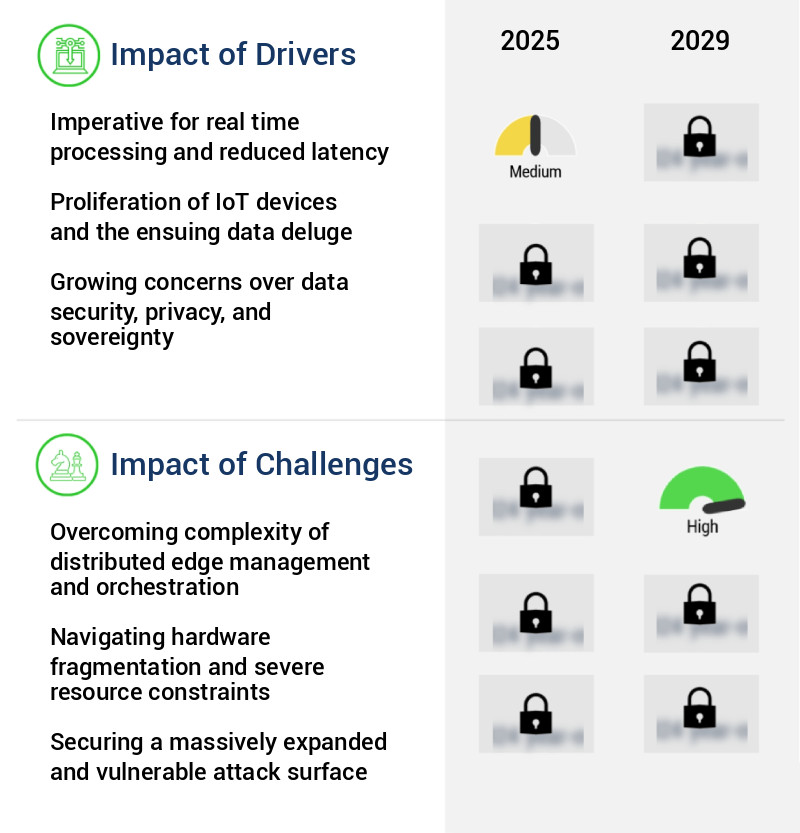
In-Depth Market Segmentation: Edge AI Software Market
The edge ai software industry research report provides comprehensive data (region-wise segment analysis), with forecasts and estimates in "USD million" for the period 2025-2029, as well as historical data from 2019-2023 for the following segments.
- Component
- Deployment
- Application
- Smart manufacturing
- Predictive maintenance
- Intelligent surveillance and monitoring
- Autonomous vehicles
- Others
- Geography
- North America
- Europe
- APAC
- Australia
- China
- India
- Japan
- South Korea
- Rest of World (ROW)
By Component Insights
The solutions segment is estimated to witness significant growth during the forecast period.
The market is experiencing significant growth as businesses increasingly prioritize real-time data processing, data privacy, and minimizing latency and bandwidth consumption. The solutions sub-segment, which includes software platforms, frameworks, and algorithms for AI processing on edge devices, is a critical component of this market. This segment's importance stems from its ability to enable developers and organizations to build, deploy, and manage AI models without relying on centralized cloud infrastructure. Key drivers for this sub-segment include the escalating demand for industrial automation, autonomous vehicles, smart cities, and consumer electronics applications. The solutions landscape encompasses various elements, such as distributed computing frameworks, anomaly detection algorithms, model optimization strategies, and software development kits.
Additionally, edge computing platforms support computer vision applications, on-device inference, model deployment strategies, cloud connectivity options, and more. With the integration of IoT device integration, sensor data, audio signal processing, and natural language processing, the market's potential for innovation continues to expand. One notable statistic reveals that over 75% of enterprise-generated data is created and processed outside of traditional centralized data centers, highlighting the market's growing significance.
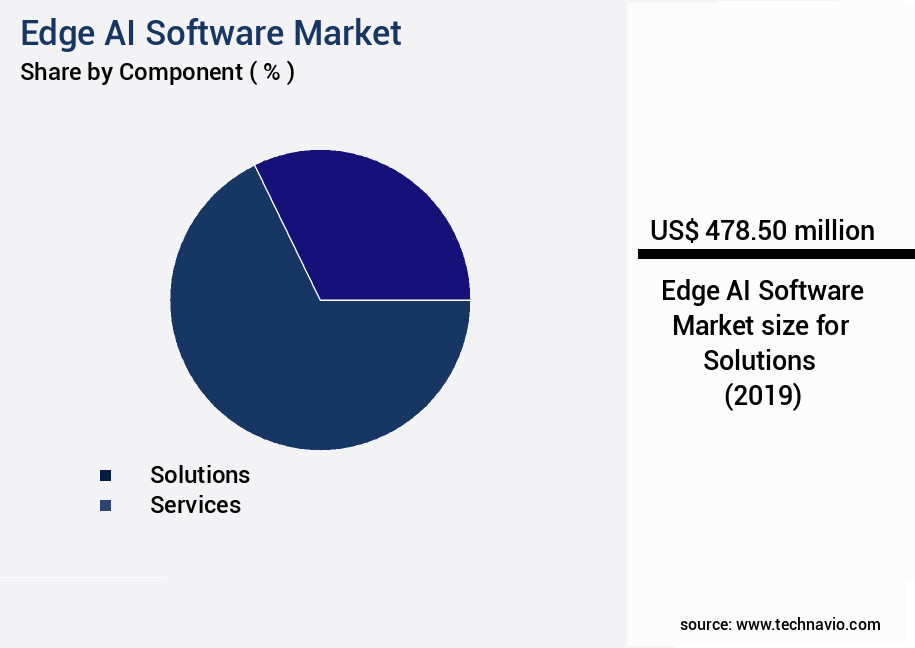
Request Free Sample
The Solutions segment was valued at USD 478.50 billion in 2019 and showed a gradual increase during the forecast period.
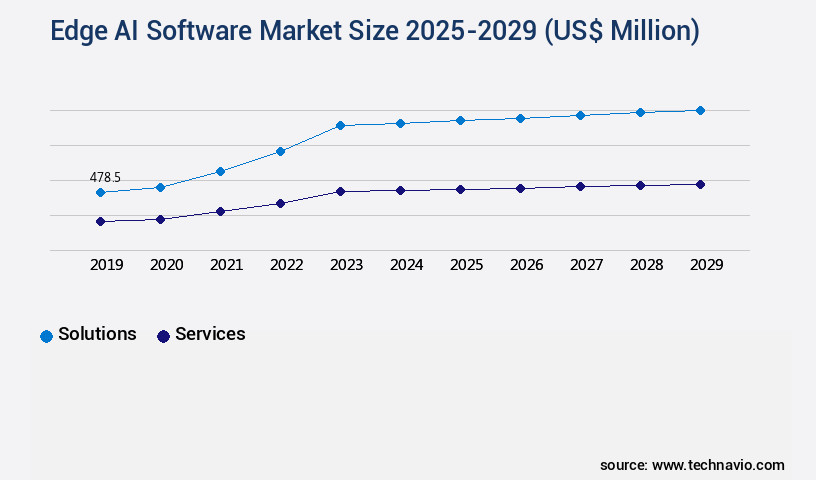
Request Free Sample
Regional Analysis
North America is estimated to contribute 42% to the growth of the global market during the forecast period.Technavio’s analysts have elaborately explained the regional trends and drivers that shape the market during the forecast period.
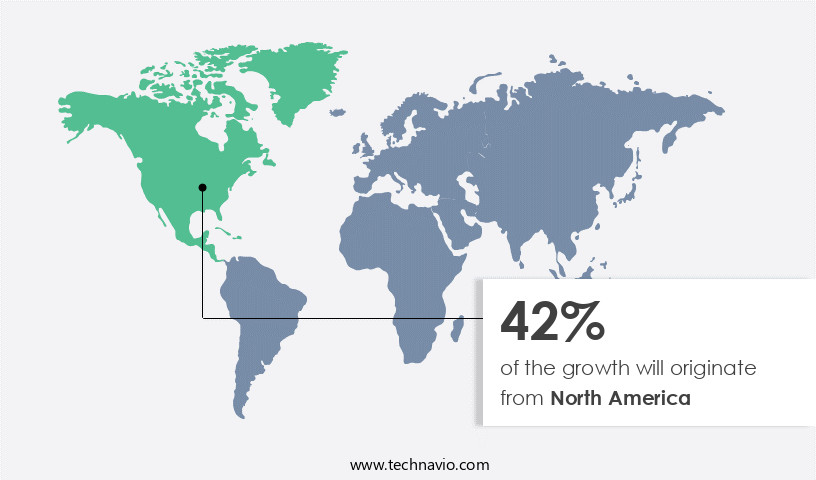
See How Edge AI Software Market Demand is Rising in North America Request Free Sample
The market is experiencing significant growth and evolution, with North America leading the global landscape. This dominance is driven by a robust technological ecosystem, substantial R&D investment, and the presence of major semiconductor, software, and cloud computing corporations based in the region, particularly in the United States. The market's momentum is fueled by high adoption rates in key verticals, including automotive, consumer electronics, retail, and healthcare. The competitive landscape is intensely dynamic, with tech giants like NVIDIA, Qualcomm, Intel, Google, Microsoft, and Apple driving innovation and advanced edge AI software development and deployment. According to recent reports, the market is expected to grow at an impressive pace, with one study estimating a 25% increase in operational efficiency gains for businesses adopting edge AI solutions.
Another study reveals that edge AI software can reduce costs by up to 40% compared to traditional cloud-based AI systems. These factors underscore the market's potential and the significant opportunities it presents for businesses and innovators alike.
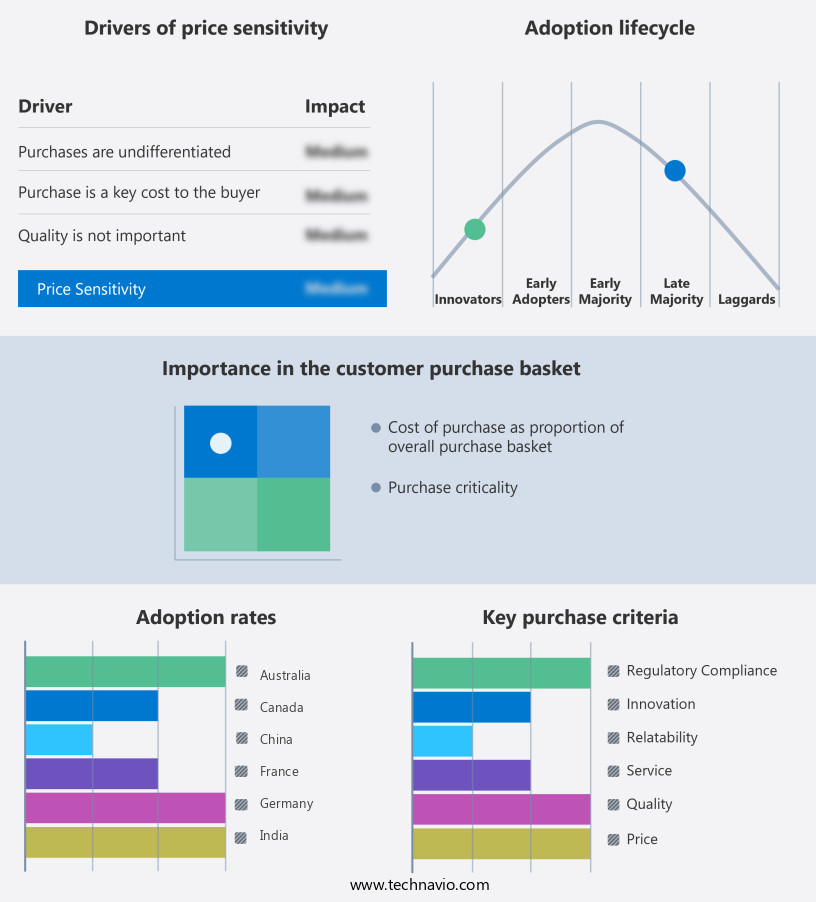
Customer Landscape of Edge AI Software Industry
Competitive Intelligence by Technavio Analysis: Leading Players in the Edge AI Software Market
Companies are implementing various strategies, such as strategic alliances, edge ai software market forecast, partnerships, mergers and acquisitions, geographical expansion, and product/service launches, to enhance their presence in the industry.
Alibaba Cloud - This company specializes in edge AI technology, providing advanced software solutions through the Tongyi Qianwen model. They offer multimodal AI services, including natural language processing, computer vision, and speech interaction tools, all suitable for edge deployment. Their offerings enable businesses to implement AI capabilities directly on devices, enhancing efficiency and performance.
The industry research and growth report includes detailed analyses of the competitive landscape of the market and information about key companies, including:
- Alibaba Cloud
- Amazon Web Services Inc.
- Axelera AI B.V.
- Baidu Inc.
- ClearBlade Inc.
- Edgeimpulse, Inc.
- Google LLC
- Hewlett Packard Enterprise Co.
- Huawei Technologies Co. Ltd.
- Intel Corp.
- International Business Machines Corp.
- Kyndryl Inc.
- Microsoft Corp.
- Nutanix Inc.
- NVIDIA Corp.
- Oracle Corp.
- Qualcomm Inc.
- Synaptics Inc.
- TIBCO Software Inc.
Qualitative and quantitative analysis of companies has been conducted to help clients understand the wider business environment as well as the strengths and weaknesses of key industry players. Data is qualitatively analyzed to categorize companies as pure play, category-focused, industry-focused, and diversified; it is quantitatively analyzed to categorize companies as dominant, leading, strong, tentative, and weak.
Recent Development and News in Edge AI Software Market
- In August 2024, Intel announced the launch of its new Edge AI software suite, "Intel® Edge AI Elements," designed to simplify the deployment and management of AI models at the edge. This solution aims to address the growing demand for real-time, local AI processing and reduce the reliance on cloud infrastructure (Intel Press Release, 2024).
- In November 2024, NVIDIA and Microsoft entered into a strategic partnership to integrate NVIDIA's Jetson edge AI platform with Microsoft Azure IoT and Azure AI services. This collaboration aims to streamline the development, deployment, and management of AI applications at the edge for industries like manufacturing, healthcare, and retail (NVIDIA Press Release, 2024).
- In February 2025, Google's DeepMind revealed the successful deployment of its "WaveNet" text-to-speech model on the edge using TensorFlow Lite. This breakthrough demonstrates the potential for advanced AI models to be run locally on devices, reducing latency and improving user experience (DeepMind Blog, 2025).
- In May 2025, Arm announced a USD120 million investment in its edge AI software ecosystem, including the acquisition of SensiML and the expansion of its partnership with Microsoft. This investment is aimed at accelerating the development and deployment of AI solutions for edge devices, particularly in the automotive and industrial sectors (Arm Press Release, 2025).
Dive into Technavio’s robust research methodology, blending expert interviews, extensive data synthesis, and validated models for unparalleled Edge AI Software Market insights. See full methodology.
|
Market Scope
|
|
Report Coverage
|
Details
|
|
Page number
|
241
|
|
Base year
|
2024
|
|
Historic period
|
2019-2023 |
|
Forecast period
|
2025-2029
|
|
Growth momentum & CAGR
|
Accelerate at a CAGR of 28.4%
|
|
Market growth 2025-2029
|
USD 4773.1 million
|
|
Market structure
|
Fragmented
|
|
YoY growth 2024-2025(%)
|
26.7
|
|
Key countries
|
US, China, Germany, Japan, UK, Canada, South Korea, France, India, and Australia
|
|
Competitive landscape
|
Leading Companies, Market Positioning of Companies, Competitive Strategies, and Industry Risks
|
Request Free Sample
Why Choose Technavio for Edge AI Software Market Insights?
"Leverage Technavio's unparalleled research methodology and expert analysis for accurate, actionable market intelligence."
The market is experiencing significant growth as businesses seek to implement real-time object detection and recognition capabilities in their operations. The edge AI software development lifecycle encompasses the design, development, and deployment of on-device deep learning inference engines for low-power embedded vision systems. This approach enables efficient data preprocessing and model optimization for resource-constrained devices, allowing for AI model retraining strategies on edge devices.
Performance evaluation metrics, such as latency and accuracy, are crucial in the selection and implementation of edge AI platforms. Robustness testing is essential to ensure the reliability of these systems in various environments, with secure data transmission protocols safeguarding sensitive information during transmission.
Scalable edge AI architecture design principles are essential to accommodate the increasing demand for AI-driven predictive maintenance solutions and operational planning. In comparison to traditional cloud-based AI systems, edge AI solutions offer reduced latency and increased autonomy, providing businesses with a competitive edge in industries such as supply chain and manufacturing.
When evaluating edge AI platforms, businesses should consider factors such as model optimization, efficient data preprocessing, and performance evaluation metrics. Additionally, managing data security in edge AI deployments is crucial, with secure data transmission protocols and robust encryption methods essential to protect sensitive information.
The adoption of edge AI is set to grow exponentially, with a recent study indicating a 50% increase in edge AI implementation in the next three years compared to the previous period. This growth is driven by the need for real-time decision making, increased operational efficiency, and improved compliance with industry regulations. By implementing edge AI solutions, businesses can gain valuable insights from their data, enabling them to optimize their operations and gain a competitive advantage.
What are the Key Data Covered in this Edge AI Software Market Research and Growth Report?
-
What is the expected growth of the Edge AI Software Market between 2025 and 2029?
-
What segmentation does the market report cover?
-
The report is segmented by Component (Solutions and Services), Deployment (Cloud, On premises, and Hybrid), Application (Smart manufacturing, Predictive maintenance, Intelligent surveillance and monitoring, Autonomous vehicles, and Others), and Geography (North America, Europe, APAC, Middle East and Africa, and South America)
-
Which regions are analyzed in the report?
-
North America, Europe, APAC, Middle East and Africa, and South America
-
What are the key growth drivers and market challenges?
-
Who are the major players in the Edge AI Software Market?
-
Alibaba Cloud, Amazon Web Services Inc., Axelera AI B.V., Baidu Inc., ClearBlade Inc., Edgeimpulse, Inc., Google LLC, Hewlett Packard Enterprise Co., Huawei Technologies Co. Ltd., Intel Corp., International Business Machines Corp., Kyndryl Inc., Microsoft Corp., Nutanix Inc., NVIDIA Corp., Oracle Corp., Qualcomm Inc., Synaptics Inc., and TIBCO Software Inc.
We can help! Our analysts can customize this edge ai software market research report to meet your requirements.
Get in touch
1 Executive Summary
- 1.1 Market overview
- Executive Summary - Chart on Market Overview
- Executive Summary - Data Table on Market Overview
- Executive Summary - Chart on Global Market Characteristics
- Executive Summary - Chart on Market by Geography
- Executive Summary - Chart on Market Segmentation by Component
- Executive Summary - Chart on Market Segmentation by Deployment
- Executive Summary - Chart on Market Segmentation by Application
- Executive Summary - Chart on Incremental Growth
- Executive Summary - Data Table on Incremental Growth
- Executive Summary - Chart on Company Market Positioning
2 Technavio Analysis
- 2.1 Analysis of price sensitivity, lifecycle, customer purchase basket, adoption rates, and purchase criteria
- Analysis of price sensitivity, lifecycle, customer purchase basket, adoption rates, and purchase criteria
- 2.2 Criticality of inputs and Factors of differentiation
- Overview on criticality of inputs and factors of differentiation
- 2.3 Factors of disruption
- Overview on factors of disruption
- 2.4 Impact of drivers and challenges
- Impact of drivers and challenges in 2024 and 2029
3 Market Landscape
- 3.1 Market ecosystem
- Parent Market
- Data Table on - Parent Market
- 3.2 Market characteristics
- Market characteristics analysis
4 Market Sizing
- 4.1 Market definition
- Offerings of companies included in the market definition
- 4.2 Market segment analysis
- 4.4 Market outlook: Forecast for 2024-2029
- Chart on Global - Market size and forecast 2024-2029 ($ million)
- Data Table on Global - Market size and forecast 2024-2029 ($ million)
- Chart on Global Market: Year-over-year growth 2024-2029 (%)
- Data Table on Global Market: Year-over-year growth 2024-2029 (%)
5 Historic Market Size
- 5.1 Global Edge AI Software Market 2019 - 2023
- Historic Market Size - Data Table on Global Edge AI Software Market 2019 - 2023 ($ million)
- 5.2 Component segment analysis 2019 - 2023
- Historic Market Size - Component Segment 2019 - 2023 ($ million)
- 5.3 Deployment segment analysis 2019 - 2023
- Historic Market Size - Deployment Segment 2019 - 2023 ($ million)
- 5.4 Application segment analysis 2019 - 2023
- Historic Market Size - Application Segment 2019 - 2023 ($ million)
- 5.5 Geography segment analysis 2019 - 2023
- Historic Market Size - Geography Segment 2019 - 2023 ($ million)
- 5.6 Country segment analysis 2019 - 2023
- Historic Market Size - Country Segment 2019 - 2023 ($ million)
6 Five Forces Analysis
- 6.1 Five forces summary
- Five forces analysis - Comparison between 2024 and 2029
- 6.2 Bargaining power of buyers
- Bargaining power of buyers - Impact of key factors 2024 and 2029
- 6.3 Bargaining power of suppliers
- Bargaining power of suppliers - Impact of key factors in 2024 and 2029
- 6.4 Threat of new entrants
- Threat of new entrants - Impact of key factors in 2024 and 2029
- 6.5 Threat of substitutes
- Threat of substitutes - Impact of key factors in 2024 and 2029
- 6.6 Threat of rivalry
- Threat of rivalry - Impact of key factors in 2024 and 2029
- 6.7 Market condition
- Chart on Market condition - Five forces 2024 and 2029
7 Market Segmentation by Component
- 7.1 Market segments
- Chart on Component - Market share 2024-2029 (%)
- Data Table on Component - Market share 2024-2029 (%)
- 7.2 Comparison by Component
- Chart on Comparison by Component
- Data Table on Comparison by Component
- 7.3 Solutions - Market size and forecast 2024-2029
- Chart on Solutions - Market size and forecast 2024-2029 ($ million)
- Data Table on Solutions - Market size and forecast 2024-2029 ($ million)
- Chart on Solutions - Year-over-year growth 2024-2029 (%)
- Data Table on Solutions - Year-over-year growth 2024-2029 (%)
- 7.4 Services - Market size and forecast 2024-2029
- Chart on Services - Market size and forecast 2024-2029 ($ million)
- Data Table on Services - Market size and forecast 2024-2029 ($ million)
- Chart on Services - Year-over-year growth 2024-2029 (%)
- Data Table on Services - Year-over-year growth 2024-2029 (%)
- 7.5 Market opportunity by Component
- Market opportunity by Component ($ million)
- Data Table on Market opportunity by Component ($ million)
8 Market Segmentation by Deployment
- 8.1 Market segments
- Chart on Deployment - Market share 2024-2029 (%)
- Data Table on Deployment - Market share 2024-2029 (%)
- 8.2 Comparison by Deployment
- Chart on Comparison by Deployment
- Data Table on Comparison by Deployment
- 8.3 Cloud - Market size and forecast 2024-2029
- Chart on Cloud - Market size and forecast 2024-2029 ($ million)
- Data Table on Cloud - Market size and forecast 2024-2029 ($ million)
- Chart on Cloud - Year-over-year growth 2024-2029 (%)
- Data Table on Cloud - Year-over-year growth 2024-2029 (%)
- 8.4 On premises - Market size and forecast 2024-2029
- Chart on On premises - Market size and forecast 2024-2029 ($ million)
- Data Table on On premises - Market size and forecast 2024-2029 ($ million)
- Chart on On premises - Year-over-year growth 2024-2029 (%)
- Data Table on On premises - Year-over-year growth 2024-2029 (%)
- 8.5 Hybrid - Market size and forecast 2024-2029
- Chart on Hybrid - Market size and forecast 2024-2029 ($ million)
- Data Table on Hybrid - Market size and forecast 2024-2029 ($ million)
- Chart on Hybrid - Year-over-year growth 2024-2029 (%)
- Data Table on Hybrid - Year-over-year growth 2024-2029 (%)
- 8.6 Market opportunity by Deployment
- Market opportunity by Deployment ($ million)
- Data Table on Market opportunity by Deployment ($ million)
9 Market Segmentation by Application
- 9.1 Market segments
- Chart on Application - Market share 2024-2029 (%)
- Data Table on Application - Market share 2024-2029 (%)
- 9.2 Comparison by Application
- Chart on Comparison by Application
- Data Table on Comparison by Application
- 9.3 Smart manufacturing - Market size and forecast 2024-2029
- Chart on Smart manufacturing - Market size and forecast 2024-2029 ($ million)
- Data Table on Smart manufacturing - Market size and forecast 2024-2029 ($ million)
- Chart on Smart manufacturing - Year-over-year growth 2024-2029 (%)
- Data Table on Smart manufacturing - Year-over-year growth 2024-2029 (%)
- 9.4 Predictive maintenance - Market size and forecast 2024-2029
- Chart on Predictive maintenance - Market size and forecast 2024-2029 ($ million)
- Data Table on Predictive maintenance - Market size and forecast 2024-2029 ($ million)
- Chart on Predictive maintenance - Year-over-year growth 2024-2029 (%)
- Data Table on Predictive maintenance - Year-over-year growth 2024-2029 (%)
- 9.5 Intelligent surveillance and monitoring - Market size and forecast 2024-2029
- Chart on Intelligent surveillance and monitoring - Market size and forecast 2024-2029 ($ million)
- Data Table on Intelligent surveillance and monitoring - Market size and forecast 2024-2029 ($ million)
- Chart on Intelligent surveillance and monitoring - Year-over-year growth 2024-2029 (%)
- Data Table on Intelligent surveillance and monitoring - Year-over-year growth 2024-2029 (%)
- 9.6 Autonomous vehicles - Market size and forecast 2024-2029
- Chart on Autonomous vehicles - Market size and forecast 2024-2029 ($ million)
- Data Table on Autonomous vehicles - Market size and forecast 2024-2029 ($ million)
- Chart on Autonomous vehicles - Year-over-year growth 2024-2029 (%)
- Data Table on Autonomous vehicles - Year-over-year growth 2024-2029 (%)
- 9.7 Others - Market size and forecast 2024-2029
- Chart on Others - Market size and forecast 2024-2029 ($ million)
- Data Table on Others - Market size and forecast 2024-2029 ($ million)
- Chart on Others - Year-over-year growth 2024-2029 (%)
- Data Table on Others - Year-over-year growth 2024-2029 (%)
- 9.8 Market opportunity by Application
- Market opportunity by Application ($ million)
- Data Table on Market opportunity by Application ($ million)
10 Customer Landscape
- 10.1 Customer landscape overview
- Analysis of price sensitivity, lifecycle, customer purchase basket, adoption rates, and purchase criteria
11 Geographic Landscape
- 11.1 Geographic segmentation
- Chart on Market share by geography 2024-2029 (%)
- Data Table on Market share by geography 2024-2029 (%)
- 11.2 Geographic comparison
- Chart on Geographic comparison
- Data Table on Geographic comparison
- 11.3 North America - Market size and forecast 2024-2029
- Chart on North America - Market size and forecast 2024-2029 ($ million)
- Data Table on North America - Market size and forecast 2024-2029 ($ million)
- Chart on North America - Year-over-year growth 2024-2029 (%)
- Data Table on North America - Year-over-year growth 2024-2029 (%)
- 11.4 Europe - Market size and forecast 2024-2029
- Chart on Europe - Market size and forecast 2024-2029 ($ million)
- Data Table on Europe - Market size and forecast 2024-2029 ($ million)
- Chart on Europe - Year-over-year growth 2024-2029 (%)
- Data Table on Europe - Year-over-year growth 2024-2029 (%)
- 11.5 APAC - Market size and forecast 2024-2029
- Chart on APAC - Market size and forecast 2024-2029 ($ million)
- Data Table on APAC - Market size and forecast 2024-2029 ($ million)
- Chart on APAC - Year-over-year growth 2024-2029 (%)
- Data Table on APAC - Year-over-year growth 2024-2029 (%)
- 11.6 Middle East and Africa - Market size and forecast 2024-2029
- Chart on Middle East and Africa - Market size and forecast 2024-2029 ($ million)
- Data Table on Middle East and Africa - Market size and forecast 2024-2029 ($ million)
- Chart on Middle East and Africa - Year-over-year growth 2024-2029 (%)
- Data Table on Middle East and Africa - Year-over-year growth 2024-2029 (%)
- 11.7 South America - Market size and forecast 2024-2029
- Chart on South America - Market size and forecast 2024-2029 ($ million)
- Data Table on South America - Market size and forecast 2024-2029 ($ million)
- Chart on South America - Year-over-year growth 2024-2029 (%)
- Data Table on South America - Year-over-year growth 2024-2029 (%)
- 11.8 US - Market size and forecast 2024-2029
- Chart on US - Market size and forecast 2024-2029 ($ million)
- Data Table on US - Market size and forecast 2024-2029 ($ million)
- Chart on US - Year-over-year growth 2024-2029 (%)
- Data Table on US - Year-over-year growth 2024-2029 (%)
- 11.9 China - Market size and forecast 2024-2029
- Chart on China - Market size and forecast 2024-2029 ($ million)
- Data Table on China - Market size and forecast 2024-2029 ($ million)
- Chart on China - Year-over-year growth 2024-2029 (%)
- Data Table on China - Year-over-year growth 2024-2029 (%)
- 11.10 Germany - Market size and forecast 2024-2029
- Chart on Germany - Market size and forecast 2024-2029 ($ million)
- Data Table on Germany - Market size and forecast 2024-2029 ($ million)
- Chart on Germany - Year-over-year growth 2024-2029 (%)
- Data Table on Germany - Year-over-year growth 2024-2029 (%)
- 11.11 Japan - Market size and forecast 2024-2029
- Chart on Japan - Market size and forecast 2024-2029 ($ million)
- Data Table on Japan - Market size and forecast 2024-2029 ($ million)
- Chart on Japan - Year-over-year growth 2024-2029 (%)
- Data Table on Japan - Year-over-year growth 2024-2029 (%)
- 11.12 UK - Market size and forecast 2024-2029
- Chart on UK - Market size and forecast 2024-2029 ($ million)
- Data Table on UK - Market size and forecast 2024-2029 ($ million)
- Chart on UK - Year-over-year growth 2024-2029 (%)
- Data Table on UK - Year-over-year growth 2024-2029 (%)
- 11.13 Canada - Market size and forecast 2024-2029
- Chart on Canada - Market size and forecast 2024-2029 ($ million)
- Data Table on Canada - Market size and forecast 2024-2029 ($ million)
- Chart on Canada - Year-over-year growth 2024-2029 (%)
- Data Table on Canada - Year-over-year growth 2024-2029 (%)
- 11.14 South Korea - Market size and forecast 2024-2029
- Chart on South Korea - Market size and forecast 2024-2029 ($ million)
- Data Table on South Korea - Market size and forecast 2024-2029 ($ million)
- Chart on South Korea - Year-over-year growth 2024-2029 (%)
- Data Table on South Korea - Year-over-year growth 2024-2029 (%)
- 11.15 France - Market size and forecast 2024-2029
- Chart on France - Market size and forecast 2024-2029 ($ million)
- Data Table on France - Market size and forecast 2024-2029 ($ million)
- Chart on France - Year-over-year growth 2024-2029 (%)
- Data Table on France - Year-over-year growth 2024-2029 (%)
- 11.16 India - Market size and forecast 2024-2029
- Chart on India - Market size and forecast 2024-2029 ($ million)
- Data Table on India - Market size and forecast 2024-2029 ($ million)
- Chart on India - Year-over-year growth 2024-2029 (%)
- Data Table on India - Year-over-year growth 2024-2029 (%)
- 11.17 Australia - Market size and forecast 2024-2029
- Chart on Australia - Market size and forecast 2024-2029 ($ million)
- Data Table on Australia - Market size and forecast 2024-2029 ($ million)
- Chart on Australia - Year-over-year growth 2024-2029 (%)
- Data Table on Australia - Year-over-year growth 2024-2029 (%)
- 11.18 Market opportunity by geography
- Market opportunity by geography ($ million)
- Data Tables on Market opportunity by geography ($ million)
12 Drivers, Challenges, and Opportunity/Restraints
- 12.3 Impact of drivers and challenges
- Impact of drivers and challenges in 2024 and 2029
- 12.4 Market opportunities/restraints
13 Competitive Landscape
- 13.2 Competitive Landscape
- Overview on criticality of inputs and factors of differentiation
- 13.3 Landscape disruption
- Overview on factors of disruption
- 13.4 Industry risks
- Impact of key risks on business
14 Competitive Analysis
- 14.2 Company ranking index
- 14.3 Market positioning of companies
- Matrix on companies position and classification
- 14.4 Alibaba Cloud
- Alibaba Cloud - Overview
- Alibaba Cloud - Product / Service
- Alibaba Cloud - Key offerings
- SWOT
- 14.5 Amazon Web Services Inc.
- Amazon Web Services Inc. - Overview
- Amazon Web Services Inc. - Product / Service
- Amazon Web Services Inc. - Key news
- Amazon Web Services Inc. - Key offerings
- SWOT
- 14.6 Baidu Inc.
- Baidu Inc. - Overview
- Baidu Inc. - Business segments
- Baidu Inc. - Key offerings
- Baidu Inc. - Segment focus
- SWOT
- 14.7 Google LLC
- Google LLC - Overview
- Google LLC - Product / Service
- Google LLC - Key offerings
- SWOT
- 14.8 Hewlett Packard Enterprise Co.
- Hewlett Packard Enterprise Co. - Overview
- Hewlett Packard Enterprise Co. - Business segments
- Hewlett Packard Enterprise Co. - Key news
- Hewlett Packard Enterprise Co. - Key offerings
- Hewlett Packard Enterprise Co. - Segment focus
- SWOT
- 14.9 Huawei Technologies Co. Ltd.
- Huawei Technologies Co. Ltd. - Overview
- Huawei Technologies Co. Ltd. - Product / Service
- Huawei Technologies Co. Ltd. - Key news
- Huawei Technologies Co. Ltd. - Key offerings
- SWOT
- 14.10 Intel Corp.
- Intel Corp. - Overview
- Intel Corp. - Business segments
- Intel Corp. - Key news
- Intel Corp. - Key offerings
- Intel Corp. - Segment focus
- SWOT
- 14.11 International Business Machines Corp.
- International Business Machines Corp. - Overview
- International Business Machines Corp. - Business segments
- International Business Machines Corp. - Key news
- International Business Machines Corp. - Key offerings
- International Business Machines Corp. - Segment focus
- SWOT
- 14.12 Kyndryl Inc.
- Kyndryl Inc. - Overview
- Kyndryl Inc. - Product / Service
- Kyndryl Inc. - Key offerings
- SWOT
- 14.13 Microsoft Corp.
- Microsoft Corp. - Overview
- Microsoft Corp. - Business segments
- Microsoft Corp. - Key news
- Microsoft Corp. - Key offerings
- Microsoft Corp. - Segment focus
- SWOT
- 14.14 Nutanix Inc.
- Nutanix Inc. - Overview
- Nutanix Inc. - Product / Service
- Nutanix Inc. - Key offerings
- SWOT
- 14.15 NVIDIA Corp.
- NVIDIA Corp. - Overview
- NVIDIA Corp. - Business segments
- NVIDIA Corp. - Key news
- NVIDIA Corp. - Key offerings
- NVIDIA Corp. - Segment focus
- SWOT
- 14.16 Oracle Corp.
- Oracle Corp. - Overview
- Oracle Corp. - Business segments
- Oracle Corp. - Key news
- Oracle Corp. - Key offerings
- Oracle Corp. - Segment focus
- SWOT
- 14.17 Qualcomm Inc.
- Qualcomm Inc. - Overview
- Qualcomm Inc. - Business segments
- Qualcomm Inc. - Key news
- Qualcomm Inc. - Key offerings
- Qualcomm Inc. - Segment focus
- SWOT
- 14.18 Synaptics Inc.
- Synaptics Inc. - Overview
- Synaptics Inc. - Product / Service
- Synaptics Inc. - Key offerings
- SWOT
15 Appendix
- 15.2 Inclusions and exclusions checklist
- Inclusions checklist
- Exclusions checklist
- 15.3 Currency conversion rates for US$
- Currency conversion rates for US$
- 15.4 Research methodology
- 15.7 Validation techniques employed for market sizing
- Validation techniques employed for market sizing
- 15.9 360 degree market analysis
- 360 degree market analysis
- 15.10 List of abbreviations







![]() Get the report (PDF) sent to your email within minutes.
Get the report (PDF) sent to your email within minutes.
Complimentary full Excel data with your report purchase.